10 Inexpensive Automotive USB Adapters Tested -- Are They Any Good?
First Batch: The Bullet Trio
These first three samples are the smallest. One screw is hidden behind the rating sticker to stop the metal piece’s lip from slipping off. At the other end, a tapered cylinder is pressed on top of the housing to hold the other end of the shell together and also act as the contact tip retainer.
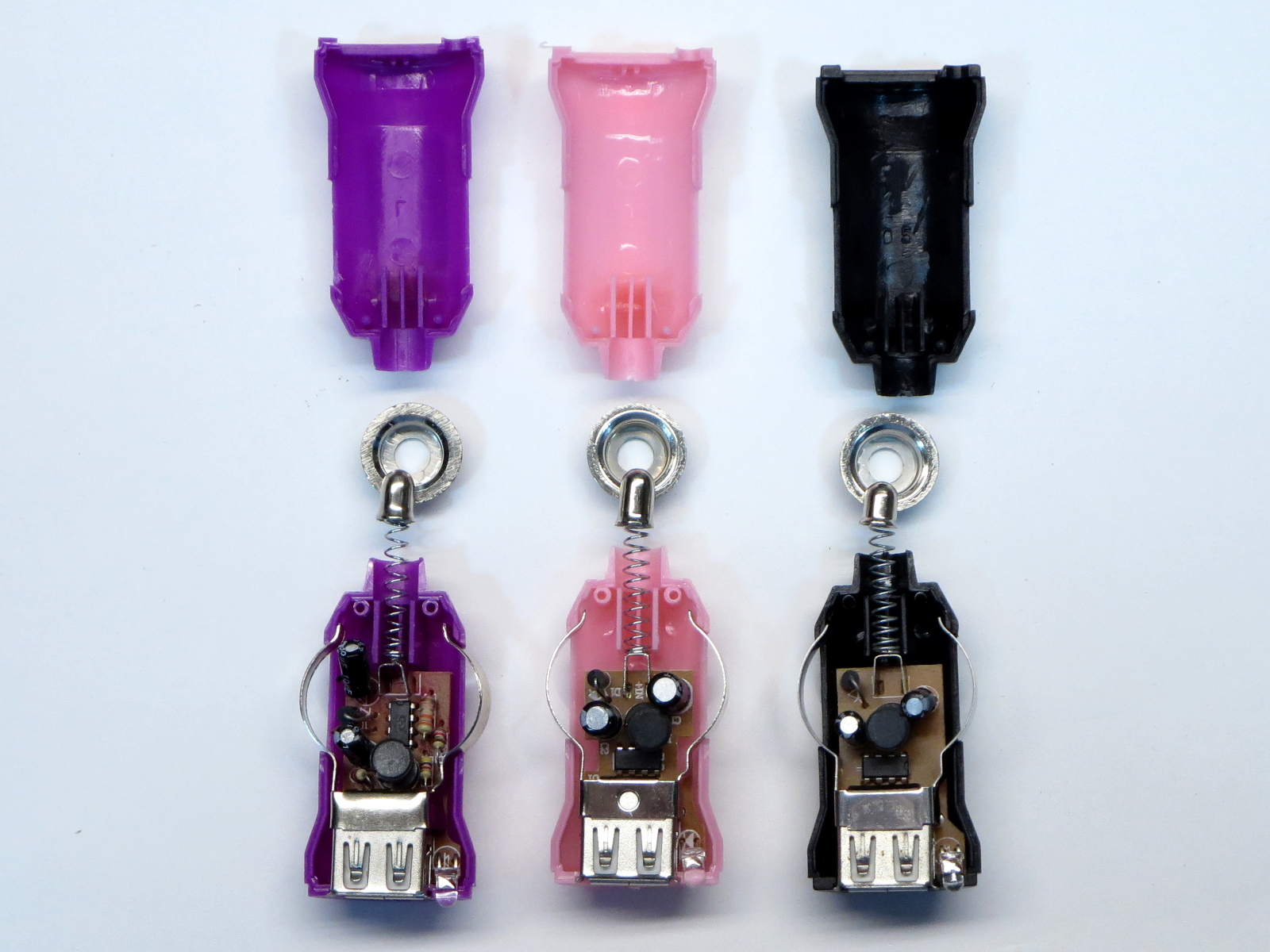
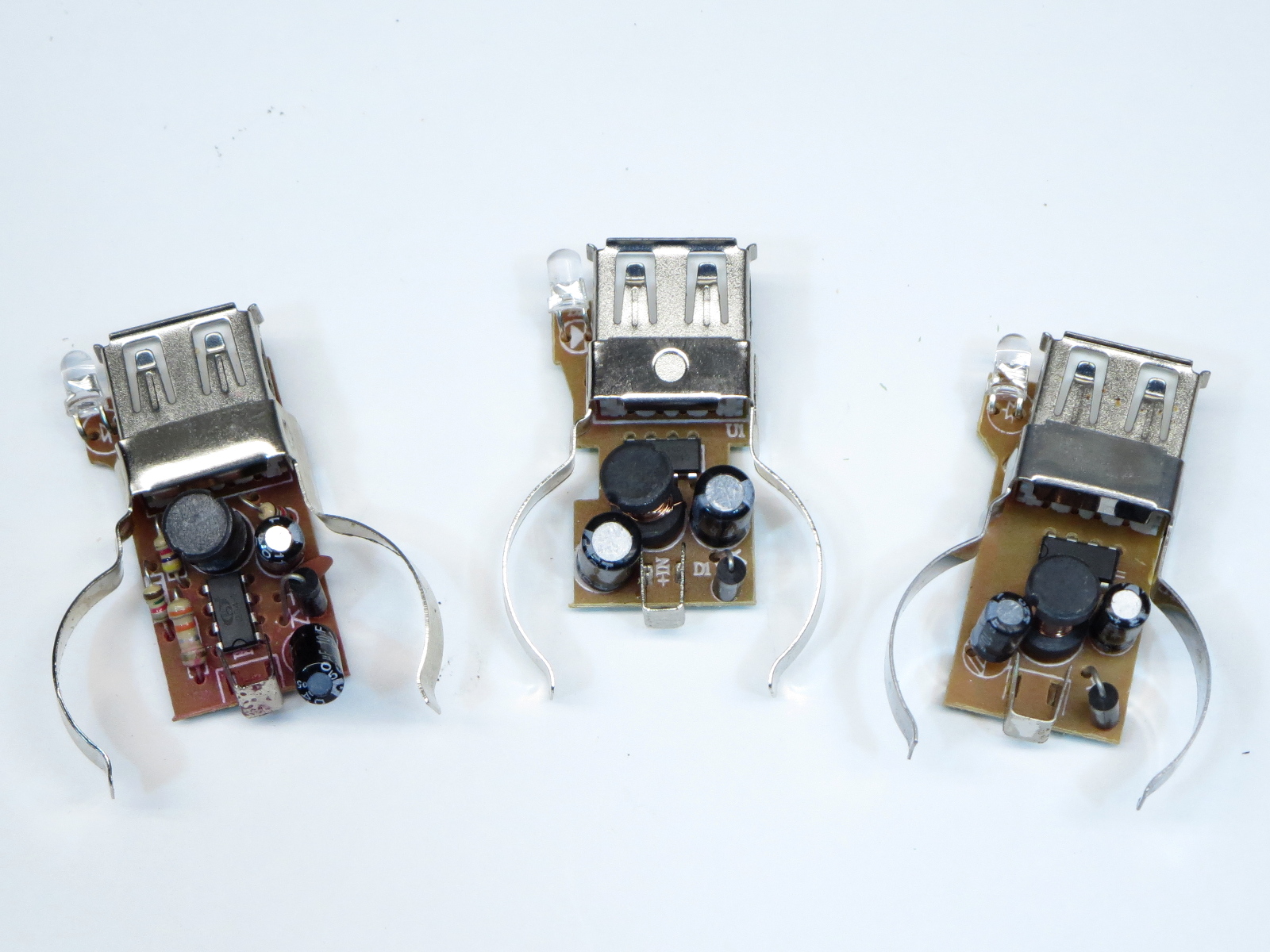
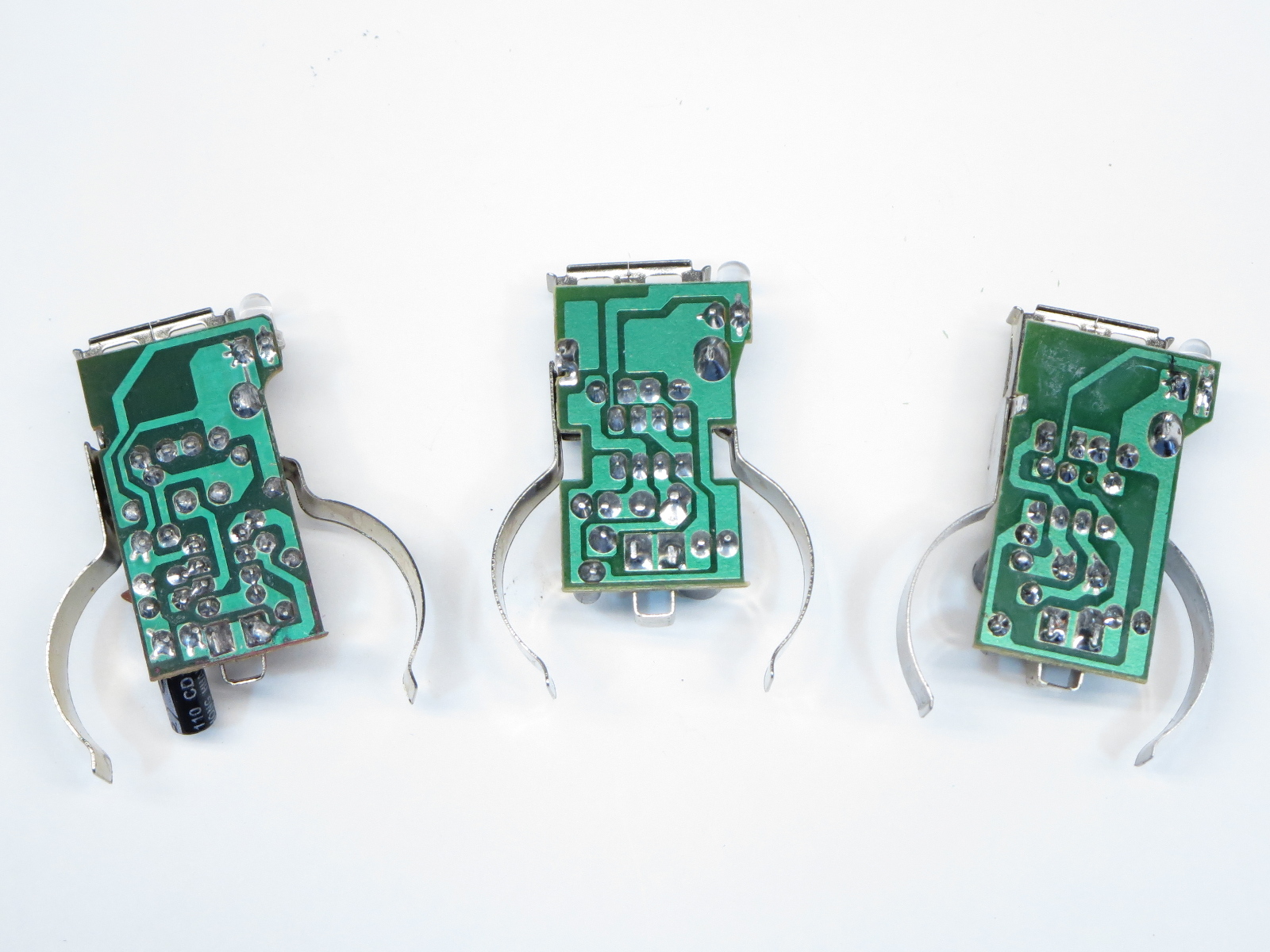
Out of the three, only the purple adapter has resistors. The other two have an inductor, input and output electrolytic filter capacitors, a three-millimeter red power indicator LED, and that’s all. Surface-mount components on the bottom side of the board? Nope, nothing so fancy on any of them. The pink and black adapters use monolithic switching regulators internally set for roughly 5.2 V output to eliminate the external feedback voltage divider and an internal timing source to eliminate the need for an external timing resistor and capacitor, reducing the component count to an absolute minimum. The purple adapter uses a chip marked 1204-1 that I cannot find any information for, while the other two use an AD84064, a generic Chinese switching regulator designed specifically for powering 5 V loads up to 1 A from source voltages up to 30 V. To nobody’s surprise, there is no input protection whatsoever in any of them.
| Header Cell - Column 0 | Purple | Pink | Black |
|---|---|---|---|
| Adapter Rating | 1000 mA | 1000 mA | 1000 mA |
| Regulator | 1204-1 | AD84064Q | AD84064Q |
| Regulator Ratings | Unknown | 30 V, 1 A, 120 kHz, 80% eff. | 30 V, 1 A, 120 kHz, 80% eff. |
| Input capacitor | Huangong 50 V, 10 µF | HL 22 µF, 35 V | G.Luxon 16 V, 22 µF |
| Output capacitor | Huangong 10 V, 100 µF | Chang 10 V, 100 µF | Jwco 10 V, 100 µF |
| Rectifier Diode | 1N5819(1 A, 40 V Schottky) | 1N5819(1 A, 40 V Schottky) | 1N5819(1 A, 40 V Schottky) |
| Input protection | None | None | None |
With its input capacitor rated for only 16 V, the black adapter is destined for a potentially tragically short useful life in an automotive environment before its capacitor goes bang. I couldn’t decipher the brand on the pink and black units’ input capacitors due to too much of it being cropped. At least the pink one’s anonymous capacitor is rated for 35 V, enough to have a reasonable chance of surviving an encounter with a 24 V system. Based on how warm all three of these got while hooked up to a 10 Ω resistor for preliminary testing, 80% efficiency might be optimistic. Since both pink and black use the same highly integrated regulator, performance should be effectively identical apart from black’s self-destruct capacitor. We’ll find out soon enough since measurements are coming up next.
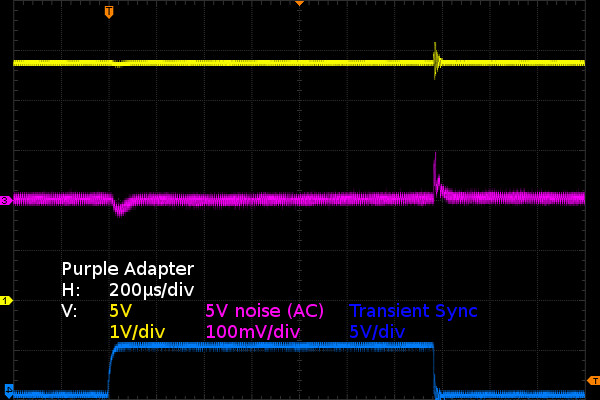


For these and all following noise performance waveforms, the yellow trace is the 5 V output measured at my dummy load with a 1 µF capacitor in parallel, the pink trace is the AC-coupled voltage at the same point and the blue trace is the gate voltage for my transient generator FET to provide a repeatable trigger for recording how these adapters respond to input voltage transients. In principle, I was supposed to take these waveforms at 1000 mA load, but since none of these units managed anywhere near that, I took the waveforms at each unit’s 4.75 V post-warmup current.
The pink and black adapters are completely indistinguishable from each other, while the purple one’s noise trace looks a little fuzzier. Overall, aside from a small amount of noise, all three units do not appear to show anything new that isn’t in the baseline waveform, which means that the bulk of the transients we see are caused by limitations in my measurement setup, not the adapters themselves.
| Header Cell - Column 0 | Test Current | Purple | Pink | Black |
|---|---|---|---|---|
| Output Voltage | 500 mA | 5.00 V | 5.09 V | 4.80 V |
| 1000 mA | Fail (540 mA @ 4.75 V) | Fail (650 mA @ 4.75 V) | Fail (520 mA @ 4.75 V) | |
| Input Power | 500 mA | 3.492 W(291 mA @ 12.00 V) | 3.96 W(330 mA @ 12.00 V) | 3.531 W(294 mA @ 12.01 V) |
| Max Sustainable | 4.265 W(356 mA @ 11.98 V) | 5.04 W(420 mA @ 12.00 V) | 3.648 W(304 mA @ 12.00 V) | |
| Efficiency | 500 mA | 72% | 64% | 68% |
| Max Sustainable | 60% | 61% | 68% | |
| Noise (RMS) | 500 mA | 47 mV | 17 mV | 33 mV |
| Max Sustainable | 15 mV @ 540 mA | 11 mV @ 600 mA | 37 mV @ 520 mA | |
| Cold Current Limit | - | 1050 mA | 1450 mA | 1060 mA |
| Hot Current Limit | - | 580 mA | 700 mA | 560 mA |
| 10 Seconds Short-Circuit | - | Pass(600 mA continuous) | Pass(700 mA continuous) | Pass(560 mA continuous) |
All three of these three adapters fail miserably at delivering on their 1000 mA output rating, and all three of them also miss the 80% efficiency mark by a wide margin, with the best of them only managing 71.5%. While the black adapter uses practically the same design as the pink one, it achieves better efficiency but worse current capacity. Looking at the board layouts, I would hazard a guess that the pink adapter fares better on output current thanks to its PCB’s extra copper providing better heat dissipation, incidentally reducing the rate at which the chip reduces its current limit. As for where the efficiency discrepancy between the two models using the same chip comes from, I would suspect less lossy capacitors and a better-built inductor.
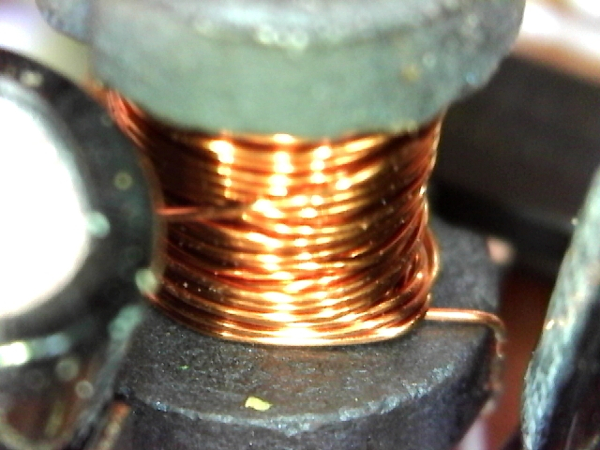

The pink adapter’s inductor in the first picture looks like it came unwound and was put back together by hand. Poor coupling and increased parasitic coupling from loose and uneven winding packing increase inductor losses and could explain a good chunk of why the pink adapter is 5% behind on efficiency. For comparison, the second picture shows the purple adapter’s inductor, which has much smoother and even windings (except for the bottom, where wire from the inner layer comes out). Seeing how much thin gauge wiring is on these spool cores, I suspect inductor winding losses account for a fair chunk of energy losses after warming up in these adapters since copper’s electrical resistance increases by 0.3% per degree Celsius or 3000ppm/°C. That would be 15% more losses after warming up by 50 °C.
Get Tom's Hardware's best news and in-depth reviews, straight to your inbox.
When cold, the purple and black adapters could barely scrape by the 1000 mA mark, while the pink one somehow managed 1.4 A despite being fundamentally the same design as the black adapter. Whatever way you slice those results, there is only one word to describe them: disappointing. Were you surprised that these “1000 mA” adapters turned out just barely adequate up to 500 mA? I was not expecting them to break records, but neither was I expecting them to deliver only 50% of their claimed rating at a mediocre 70% efficiency or worse. By the time I finished testing each one of these, my work room smelled of overheating semiconductors. The adapters themselves got quite hot, which fills me with no confidence regarding these devices’ useful life inside the bore of a 12 V power socket.
If you need a 12 V to USB power adapter, I believe it is best to avoid these awfully minimalist and grossly under-performing models. Are there better-quality adapters in this form factor? Possibly. There certainly is more than enough room to do much better with a double-sided board so I would not rule that possibility out.
Current page: First Batch: The Bullet Trio
Prev Page Benchmarking Next Page Second Batch: Bigger Bullet Duo-
SpAwNtoHell Tho have the knoledge to test all of that myself i never bothered as my intuition always pointed that generic are beter next to nothing only. Genuine branded is what i always used for the all explained and revealed in your article; like samsung charger, htc charger and so on... and i always used 12 spliters... with the incovenience of the space...Reply -
Math Geek very interesting read. never thought it through this much but always assumed the $1 adapters were junk and generally bought name brand adapters for around $10 or so.Reply
but now i wonder and almost feel like taking one apart just to see what's inside. :) -
Daniel Sauvageau Reply18542197 said:No Anker in the review is a bummer, still, thanks for doing this!
At least one of Anker's Amazon listings has a 3D render showing the internals. At a glance, it seems quite similar to the LDNIO.18542229 said:but now i wonder and almost feel like taking one apart just to see what's inside. :)
If I do another one of these roundups, I'll try to get my hands on one. -
Math Geek i have a couple of the belkin and griffin brands in my cars. they are common adapters found at walmart for $10-15 depending on the model. seems like a decent trade off form the super cheap ones and the super expensive ones.Reply
but now you got the topic started, i wonder if they are worth the price and better than the junk ones i avoided. -
Daniel Sauvageau Well, throw adapter models/brands at me and I'll look around to see which ones I can grab for a reasonable price for Round 2.Reply -
Math Geek my next trip to walmart/target i'll make some notes. they carry roughly the same type stuff as best buy as far as brands go. will look for the midrange models i'd likely buy and post some for you :)Reply -
turkey3_scratch All of these have really high ripple. The ATX spec alone (and I know these don't have to follow that) defines 50mv max for the 5VSB rail. These all chill above 100mv.Reply